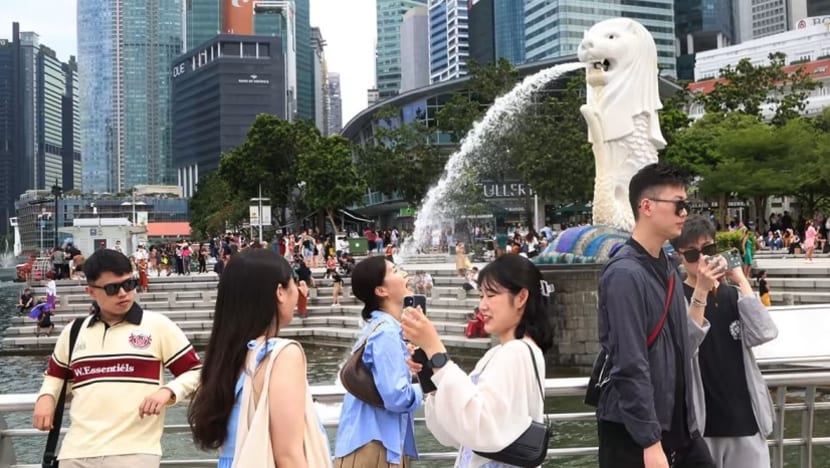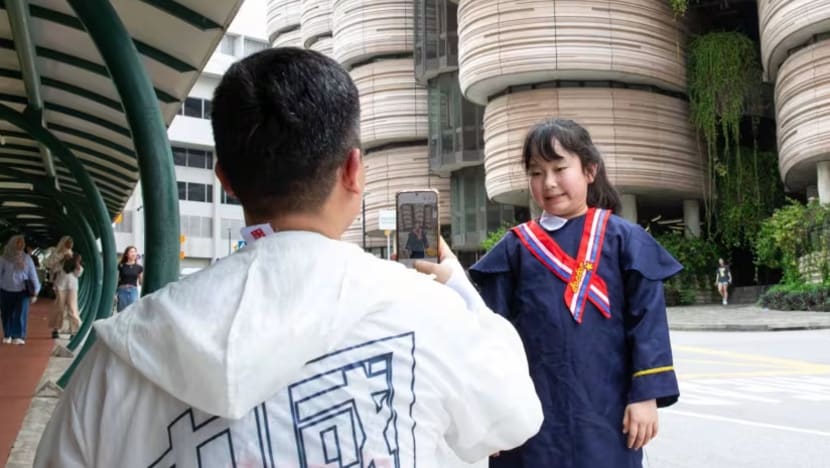Commentary: Visa waiver deal puts Singapore in good stead to attract the coveted Chinese tourist
Could a new visa exemption arrangement give Singapore the boost to attract more tourists from China? A beleaguered Chinese economy means that Singapore must look beyond its pre-pandemic edge and play its cards right, says travel industry writer Ng Yixin.


This audio is generated by an AI tool.
SINGAPORE: Where are all the Chinese tourists? The once ubiquitous throngs remain whispers from the past for many tourist hotspots around the world. In the year since China re-opened borders post-pandemic, outbound travel has had a sputtering restart.
The answer to the question seems to be: Singapore, hopefully. Singapore is swooping in on an anticipated spike, with a mutual visa waiver with China that took effect on Friday (Feb 9), the eve of Chinese New Year.
Citizens can enter the other country without a visa for stays up to 30 days for business, tourism, personal visits and other private affairs. Before this agreement, Chinese citizens required a visa while Singaporeans holding ordinary passports benefited from a 15-day visa waiver.
The sluggish resumption of outbound travel from China is standing between Southeast Asia’s destinations and full tourism recovery.
Pre-pandemic, China was one of Southeast Asia’s fastest growing feeder markets, and Singapore’s largest. But visitor arrivals from China to Singapore totalled just over 1.4 million in 2023, according to the Singapore Tourism Board’s numbers released earlier this month, down from 3.6 million in 2019.
Could this arrangement renew Singapore’s appeal to Chinese tourists?
KEEPING SINGAPORE ATTRACTIVE
Well, Chinese tourists are biting, it seems.
Trip.com (which owns the popular Chinese booking site Ctrip) saw Chinese bookings to Singapore surge to more than 13 times for the Chinese New Year period over the comparable period in 2023, a company spokesperson told me. On the day following the announcement, the surge was 120 per cent over the same day the week before.
Fliggy, another leading online travel agency in China, saw travel product bookings for Chinese New Year grow 21-fold (as at Feb 6), compared to the festive period in 2023. Leisure activity bookings increased by more than 30 times, a spokesperson revealed, and hotel bookings exceeded pre-pandemic levels.
China’s travel agency giants expect visa exemption to keep Singapore attractive beyond the seasonal jumpstart.
“If we look at the areas that have been doing very well over the past year, the first are GCC (Gulf Cooperation Council) countries in the Middle East. Qatar and Dubai have favourable visa policies and make arrival convenient; other nations have online visa application procedures that are convenient and easy.
"Now that Singapore and China will be implementing reciprocal visa-free travel, we certainly see more Chinese travellers choosing to visit Singapore due to the increased convenience,” Mr Edmund Ong, general manager of Trip.com Singapore, told me.
MIRAGE OF CHINA’S REVENGE TRAVELLERS
It may appear, wishfully, that China is finally unleashing its revenge travellers in full force. But China’s economic troubles are too big to ignore.
The slow return of outbound travel was largely attributed to China’s disappointing economic restart coming out of the pandemic. As of September 2023, Chinese outbound tourism expenditure was still down 18 per cent from pre-pandemic levels, according to the United Nations World Tourism Organization.
Economic forecasts for 2024 have only gotten worse, with various experts projecting China’s GDP growth to slow from 5.2 per cent in 2023 to between 4 and 4.6 per cent in 2024.
The country cannot conceivably get out of its litany of economic troubles any time soon: A serious deflation spiral, record drops in salaries, a property market crisis, high youth unemployment rates - and the list goes on.
THE RISE OF THE PRUDENT TRAVELLER
In this climate, perhaps the foremost question is not where, but how the Chinese would be travelling in 2024.
Already emerging is a picture of the prudent Chinese traveller, mediating economic anxieties while they vacation - whether by planning their academic journey overseas, or hitting multiple destinations to stretch the flight buck.

In recent weeks, the spectre of overtourism re-emerged in an unforeseen domain in Singapore: Universities.
Almost like something out of a fever dream, camera-toting tourists swarmed the country’s top tertiary institutions, holding up canteen lines and crowding buses - to the point that the Nanyang Technological University (NTU) has put in place measures such as an approval process for visitors or tour agencies, pre-registration for scheduled slots and an entry fee.
The secretary-general of Bossa Cossa, a Chinese association of study abroad agencies, Mr Chenxing Sang, shared with me that ranking-conscious Chinese are typically drawn to Singapore’s top universities or private colleges that deliver British or Australian degrees.
Now, cost-sensitivity is driving an influx of Chinese scoping out the best academic opportunities in Singapore, instead of pricier prestige programmes in the United States and United Kingdom.
Mr Jon Santangelo, an association spokesperson, explained that more students are increasingly opting to stay within Asia due not only to the proximity but also perceived value and lower tuition costs.
FROM COMPETITION TO SHARED OPPORTUNITIES
That Thailand is introducing its own visa exemption for Chinese travellers is not bad news for Singapore. Value-conscious travellers looking to make the most out of their flights to Southeast Asia will be keen to cover multiple destinations.
Singapore is in a position to share in the tourism opportunities of regional “golden child” Thailand, court travellers seeking more than shopping and gaming or who may not have previously had Singapore on their radar. According to Fliggy, Sentosa Island, Singapore Zoo and Gardens by the Bay are now among the most booked attractions in Singapore.
“Now that (Singapore, Malaysia and Thailand) have visa-free travel arrangements with China, we definitely see an increase not just in travel to each of these countries, but also in itineraries with two or even all three of them,” observed Trip.com’s Mr Ong.
Chinese gaming enthusiasts have been a mainstay of Singapore’s tourism. However, one can only speculate as to the impact of economic uncertainty on gaming revenues. Not only does the Singapore Tourism Board exclude gaming expenditure from reported tourism receipts, the two big casino players in the country were tight-lipped about how much Chinese patrons spend when contacted.
There is room for tourism innovation in the mass market. Resorts World Sentosa is positioning itself as a “lifestyle destination” and giving travellers more reasons to visit, having lined up a series of events such as Sneaker Con SEA 2024 in March. The refresh of family-friendly Forum strip, addition of the Minion Land in Universal Studios Singapore and the Singapore Oceanarium are expected to soft open in early 2025.
Marina Bay Sands has recently been given government approval to build a fourth tower with 587 rooms. Its multi-billion-dollar expansion plan announced in 2019 also expected to add event facilities and a 15,000-seater entertainment arena.
One thing is for sure. A larger paradigm shift must happen to court the prudent Chinese tourist amid battered consumer confidence.
Ng Yixin is a Singapore-based independent writer for travel, sustainability and enterprise.



















